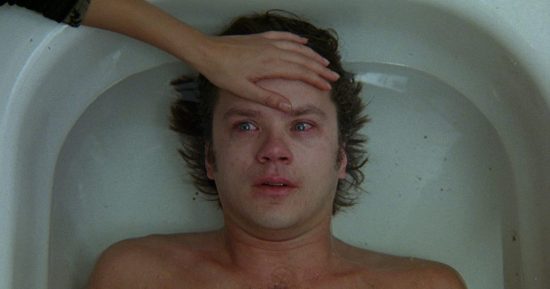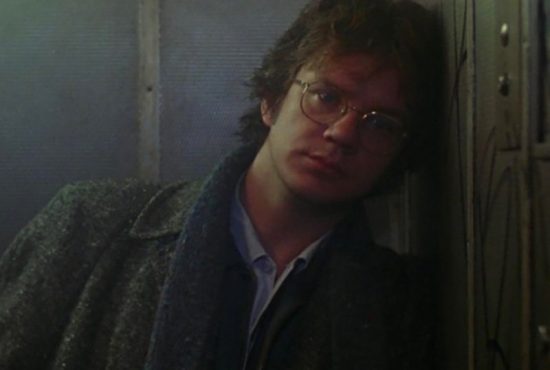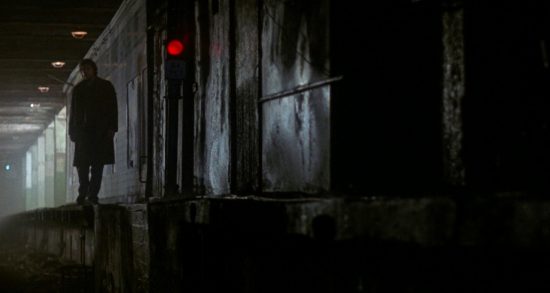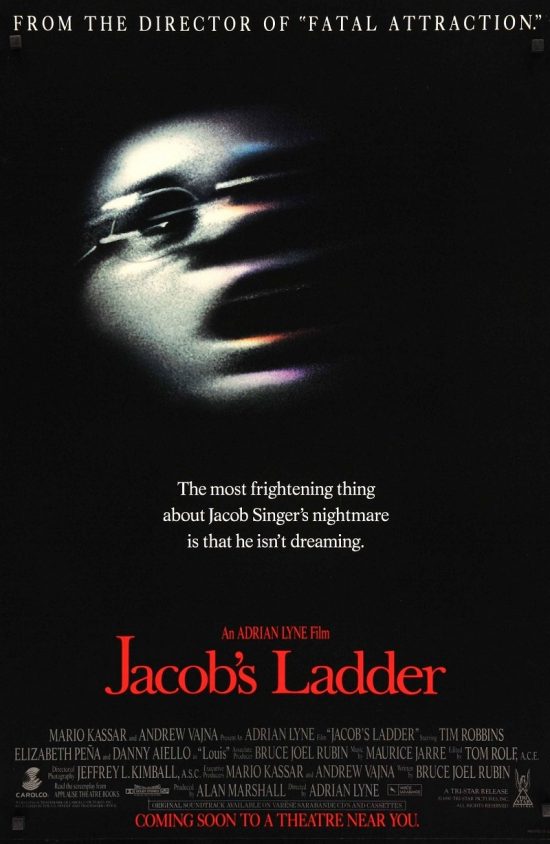Retro Review: Jacob’s Ladder (1990) – America’s Forgotten Horror
Jacob’s Ladder (1990), directed by Adrian Lyne tells the story of Jacob Singer (Tim Robbins), a Vietnam veteran haunted by the death of his son who begins to suffer from disturbing and violent visions. As his paranoia and alienation increase, Jacob learns he may not be the only one from his old platoon that is seeing things. As his search for the truth of what really happened to him in Vietnam takes him deeper and deeper into a nightmare world, he begins to question what and who is real in his life.
Director Adrian Lyne initially found success in 1983 with FLASHDANCE, and then subsequently followed it up with further box office success with 9½ WEEKS (1986) starring Mickey Rourke and Kim Basinger. He then directed FATAL ATTRACTION (1987) with Michael Douglas and Glenn Close, which was the third highest-grossing movie of 1987, behind PLATOON (1987) and BEVERLY HILLS COP II (1987). Lyne’s films to date were some of the most successful and iconic of the 80s, epitomising the decade’s obsession with style, sex and glamour. But with JACOB’S LADDER, Lyne took a much darker approach in terms of style, taking inspiration from artists such William Blake and H.R Giger.
Lyne creates a modern-day Brueghel scene, where demonic figures inflict pain and suffering in plain view of everyday life, seemingly by those around. With his use of slow frame rates played at a standard rate, disturbing imagery and flash cuts, Lyne pulls the audience deeper and deeper into a fever dream that argues given the right stimulus, we are all capable of unspeakable acts of horror.
The screenplay was written by Bruce Joel Rubin, whose previous credits included the Douglas Trumball directed BRAINSTORM (1983) and would also go on to include GHOST (1990) which came out the same year as JACOB’S LADDER and was the highest-grossing film for 1990, earning Whoopi Goldberg an Oscar. The script was widely regarded for many years in Hollywood as brilliant but almost impossible to make. Originally, the film’s demons were visually more traditional in that they were creatures with horns, cloven hooves and wings. Lyne felt demons with horns and wings had been seen many times before and would not be taken seriously by modern-day audiences and so decided to give Jacob’s tormentors an appearance closer to human form and at first glance could almost be human. This simple change results in a disturbing aesthetic, playing on the idea that we can be our own demons and true evil is within ourselves.
For Tim Robbins, JACOB’S LADDER represented somewhat of a departure from light-hearted and comedic roles in films such as BULL DURHAM (1988) and ERIK THE VIKING (1989). His everyman performance carries the film, giving the audience a central character they can believe in and care about, a trait many films in the horror genre lack. He would go on to star in Robert Altman’s acerbic Hollywood satire, THE PLAYER (1992), the Coen brothers’ THE HUDSUCKER PROXY (1994) and the career-defining THE SHAWSHANK REDEMPTION (1994).
Elizabeth Pena plays Jezzie, Jacob’s girlfriend with great balance and subtlety as Jacob and the audience are never quite sure if her presence in his life is a benign or malicious influence. Having previously starred in LA BAMBA (1987) and *BATTERIES NOT INCLUDED (1987) and would go on to star in John Sayles’ superb but largely unseen LONE STAR (1996).
The supporting cast reads like an impressive 90s who’s who list with Matt Craven, Ving Rhames, Pruitt Taylor Vince, Erik La Salle, Jason Alexander and an uncredited appearance by Macaulay Culkin who was about to shoot to international stardom in HOME ALONE (1990). The standout supporting performance comes from Danny Aiello as Jacob’s chiropractor, Louis. His scenes provide an almost Zen-like tranquillity and serve as calm centres at the heart of the storm of paranoia and violent demonic visions.
The film was inexplicably released in November as the domestic market was gearing up for holiday season. A film about America’s involvement in Vietnam within a hallucinatory fever dream, horror context does not attract the family-driven box office of that time of year. It was no surprise that the film although well received by the critics did not do well at the box office, and took just over $26million.
At the start of the 90s, JACOB’S LADDER foreshadows a much darker period in American history with U.S troops once again involved in conflict on foreign soil, this time in the form of the first Gulf War. It was about to enter its first recession in over a decade, which would contribute to George Bush Senior’s defeat in the Presidential election and it would see riots on the streets of Los Angeles in protest at the acquittal of the police officers who beat Rodney King as he lay on the floor and on our television screens.
At the time of release, America was still buoyed with wide-eyed patriotism, supporting the troops as they travelled to faraway lands to defend their coincidentally oil-rich friends in Kuwait from the evil tyranny of Iraq. America was in no mood to watch a film that suggested their government would experiment on their own troops with untested drugs, destroy their lives and leave to them out to dry upon their return home. But as with many excellent horror films, JACOB’S LADDER holds a mirror up to real-world horrors and asks us to confront these realities. It examines not only the notion of individuals being capable of horrific acts of violence and cruelty but it also exposes a collective capability to dehumanise those for whom a government should have the highest duty of care. It still asks questions that for many are too painful or impossible to admit.













